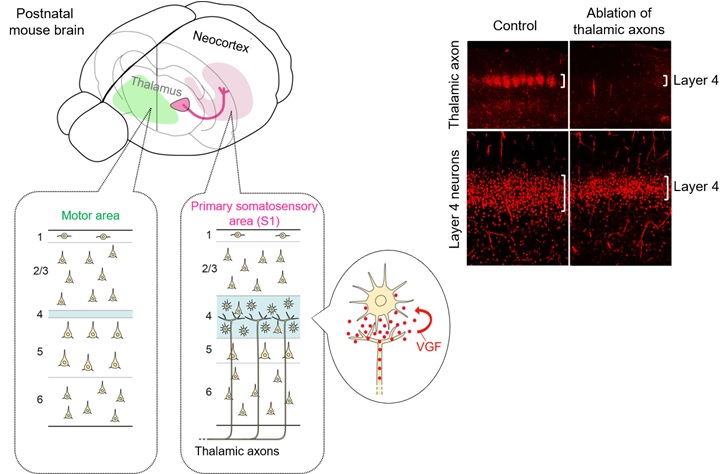
Haruka Sato, Jun Hatakeyama, Takuji Iwasato, Kimi Araki, Nobuhiko Yamamoto, Kenji Shimamura*
Thalamocortical axons control the cytoarchitecture of neocortical layers by area-specific supply of VGF
eLife
DOI: 10.7554/eLife.67549
The mammalian neocortex entirely consists of six neuronal layers. Yet, the thickness and cellular composition of each layer are not uniform throughout the neocortex, but differ among areas. Each area performs distinct function based on its unique layer structure. How the area differences in layer structure are generated across the neocortex is one of the major issues in developmental neurobiology, and has been intensively investigated worldwide.
Dr. Haruka Sato at Department of Brain Morphogenesis (Prof. Kenji Shimamura) focused on the relationship between development of thick layer 4 in the primary somatosensory cortex (S1) and the thalamocortical axons (TCAs) which project to it, and investigated the role of TCAs in the formation of area-specific layer structure. The results showed that 1) the area-specific layer structure (in this case, the development of layer 4) becomes apparent during the first postnatal week, and 2) acute ablation of TCAs at postnatal stage caused thinning of layer 4 and reduction of layer 4 neurons in S1. This led to poor distinction of S1 from other areas.
Furthermore, they identified the factor responsible for the action of TCAs as VGF which is secreted from TCA terminals. Interestingly, loss of VGF resulted in not only diminished layer 4, but also impaired barrel structure, which processes sensory information from facial whiskers.
While the idea that TCAs confer areal specificity in the neocortex has long been proposed, known as the protocortex model, only recently there has been a series of reports experimentally demonstrating how TCAs work. It appears that thalamic axons play multiple roles depending on the developmental time window. Here, Sato and colleagues pinpointed the time of TCA ablation postnatally, thereby unveiling a novel aspect of the role of thalamic axons, that is, controlling the thickness and the number of neurons in layer 4, which in turn contributes to the formation of area-specific layer cytoarchitecture. Moreover, this is the first time that the molecular identity of one of the axon-derived factors postulated in the model has been identified. These results have further deepened our understanding of the mechanisms underlying the cerebral cortex development.

Schematic of the findings: Thalamic axon-derived VGF regulates difference in layer structure among areas in the neocortex.
(Left) Layer 4 of the primary somatosensory area is thick and dense. Thalamic axons regulate the number of layer 4 neurons through secretion of VGF from their terminal. (Right) Reduction of layer 4 neurons in the absence of thalamic axons.